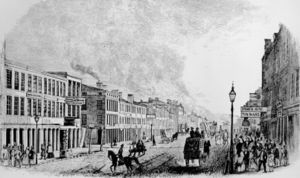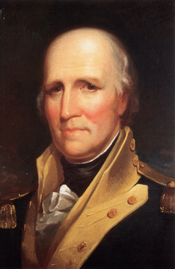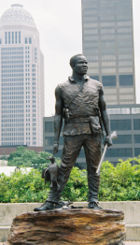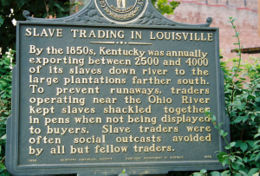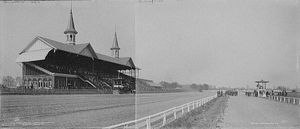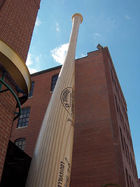History of Louisville, Kentucky
2007 Schools Wikipedia Selection. Related subjects: North American History
The history of Louisville, Kentucky spans hundreds of years, and has been influenced by the area's unique geography and location.
Pre-settlement history (pre-1778)
Although Kentucky was inhabited by Native Americans in prehistoric times, when white explorers and settlers began entering Kentucky in the mid-1700s, there were no permanent Native American settlements in the region. Instead, the country was used as hunting grounds by Shawnees from the north and Cherokees from the south.
The area was first visited by Europeans in 1669 by René-Robert Cavelier, Sieur de La Salle, from France. He explored areas of the Mississippi and Ohio river valleys from the Gulf of Mexico up to modern-day Canada, claiming much of this land for France.
In 1751, Christopher Gist explored areas along the Ohio River. Following the French and Indian War, France relinquished control of the area of Kentucky to England.
In 1769, Daniel Boone created a trail from North Carolina to Tennessee, and then spent the next two years exploring Kentucky. In 1773, Captain Thomas Bullitt led the first exploring party into Jefferson County, surveying the land on behalf of Virginians who had been awarded land grants for service in the French and Indian War. In 1774, James Harrod began constructing Fort Harrod in Kentucky. However, battles with the native American tribes established in the area forced these new settlers to retreat. They returned the following year, as Daniel Boone built the Wilderness Road and established Fort Boonesborough at the site near Boonesborough, Kentucky. The Native Americans allocated a tract of land between the Ohio River and the Cumberland River for the Transylvania Land Company. In 1776, the colony of Virginia declared the Transylvania Land Company illegal and created the county of Kentucky in Virginia from the land involved.
Foundation and early settlement (1778-1803)
The first settlement was made in the vicinity of modern-day Louisville in 1778 by Col. George Rogers Clark, who was conducting a campaign against the British in areas north of the Ohio River, then called the Illinois Country. Clark organized a group of 150 soldiers, eventually known as the Illinois Regiment, after heavy recruiting in Virginia and Pennsylvania. On May 12, they set out from Redstone, today's Brownsville, Pennsylvania, taking along 80 civilians who hoped to claim fertile farmland and start a new settlement in Kentucky, and arrived at the Falls of the Ohio on May 27. It was a location Clark thought ideal for a settlement and communication post.
The regiment helped the civilians establish a settlement on what came to be called Corn Island, clearing land and building cabins and a springhouse. On June 24, Clark took his soldiers and left to begin their military campaign. A year later, at the request of Clark, the settlers began crossing the river and established the first permanent settlement and by April were calling it "Louisville", in honour of King Louis XVI of France, whose soldiers at the time were aiding Americans in the Revolutionary War. Today, George Rogers Clark is now recognized as the founder of Louisville, and many landmarks are named after him.
During its earliest history, the colony of Louisville and the surrounding areas suffered from Indian attacks, and the Revolutionary War was still being waged, so all early residents lived within forts, as was suggested by the earliest government of Kentucky County, Virginia. The initial fort, at the northern tip of today's 12th street, was called Fort-on-Shore. In response to the threat of British attacks, particularly Bird's Invasion of Kentucky, a larger fort called Fort Nelson, after Virginia Governor Thomas Nelson, Jr., was built north of today's Main Street between Seventh and Eighth streets, covering nearly an acre. The GB£15,000 contract was given to Richard Chenoweth, with construction beginning in late 1780 and completed by March 1781. The fort, thought to be capable of resisting cannon fire, was considered the strongest in the west after Fort Pitt, but due to decreasing need for strong forts after the Revolutionary War, it would be in decline by the end of the decade.
In 1780, the Virginia General Assembly and then- Governor Thomas Jefferson approved the town charter of Louisville on May 1. Jefferson County, named after Thomas Jefferson, was formed at this time as one of three original Kentucky counties from the old Kentucky County, Virginia. Louisville was the county seat.
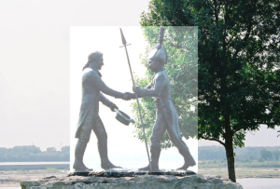
Also during 1780, 300 families immigrated to the area and Louisville's first fire department was established. The first street plan of Louisville was laid out by Willian Pope at this time. Daniel Broadhead opened Louisville's first general store in 1783. He became the first to move out of Louisville's early forts. The first courthouse was completed in 1784, a 16 by 20-foot log cabin. By this time, Louisville contained 63 clapboard finished houses, 37 partly finished, 22 uncovered houses, and over 100 log cabins. Shippingport, incorporated in 1785, was a vital part of early Louisville, allowing goods to be transported through the Falls of the Ohio. The first church was built in 1790, the first hotel in 1793, and the first post office in 1795. However, the town was not growing as fast as Lexington during the 1780s and early 1790s, due to a variety of reasons, such as the threat of Indian attacks (ended in 1794 by the Battle of Fallen Timbers), a complicated dispute over land ownership between John Campbell and the town's trustees (resolved in 1785), as well as Spanish policies restricting trade down the Mississippi to New Orleans. By 1800, the population of Louisville was 359, to Lexington's 1,759.
From 1784 through 1792, a series of conventions were held to discuss the separation of Kentucky from Virginia. On June 1, 1792, Kentucky became the fifteenth state in the United States and Isaac Shelby was named the first Governor.
In 1803, Meriwether Lewis and William Clark organized their expedition across America at the Falls of the Ohio and Louisville. The Lewis and Clark Expedition would take the explorers across the western U.S., surveying the Louisiana Purchase, and eventually to the Pacific Ocean.
City development (1803-1900)
Antebellum
Since settlement, all people and cargo had arrived by flatboat and later keelboat, non-motorized vessels, meaning that it was prohibitively costly to send goods upstream (towards Pittsburg and other developed areas). This technical limitation, combined with the Spanish decision in 1784 to close the Mississippi River below Vicksburg to American ships, meant there was little outside market for goods produced early on in Louisville. This improved somewhat with Pinckney's Treaty, which opened the river and made New Orleans a free-trade zone by 1798.
However, most cargo was still being sent downstream in the early 19th century, averaging 60,000 tons downstream to 6,500 tons upstream. Boats passing through still had to unload all of their cargo before navigating the falls, a boon to local businesses. The frontier days quickly fading, log-houses and forts began to disapear, and Louisville saw its first newspaper, the Louisville Gazette in 1807 and its first theatre in 1808, and the first dedicated church building in 1809. All of this reflected the 400% growth in population reported by the 1810 Census.
The economics of shipping were about the change, however, with the arrival of steamboats. The first, The New Orleans arrived in 1811, travelling downstream from Pittsburg. Although it made the trip in record time, few felt it was very meaningful at the time, believing a steamboat could make it back upstream against the current. However, in 1815, the Enterprise, captained by Henry Miller Shreve became the first steamboat to travel all the way from New Orleans to Louisville, showing the commercial potential of the steamboat.
Industry and manufacturing reached Louisville and surrounding areas, especially Shippingport, at this time. Some steamboats were built in Louisville, and many early mills and factories opened. Other town sites were developing at the falls: New Albany, Indiana in 1813 and Portland in 1814. Still, Louisville's population grew rapidly, tripling from 1810 to 1820. By 1830, it would surpass Lexington to become the state's largest city.
The city's first library opened its doors in 1816, known as the Louisville Library Company, and started a subscription-based service. Also, in a series of events ranging from 1798 to 1846, the University of Louisville was founded from the Jefferson Seminary, Louisville Medical Institute and Louisville Collegiate Institute.
In response to great demand, the Louisville and Portland Canal was completed in 1830. This allowed the transportation of boat traffic to circumvent the Falls of the Ohio and travel through from Pittsburgh to New Orleans. While the canal would lead to the gradual decline of Shippingport, Louisville continued to thrive. In response to several epidemics, and the increasing need to treat ill or injured river workers, Louisville Marine Hospital was completed in 1825 on Chestnut Street, an area that is today home to Louisville's Medical Centre.
In 1828, the population reached a size of 7,000, and Louisville became an incorporated city, the first in Kentucky. John Bucklin was elected the first Mayor. The nearby towns of Shippingport and Portland remained independent of Louisville for the time being. City status gave Louisville some judicial authority and the ability to collect more taxes, which allowed for the establishment of the state's first public school in 1829.
In 1831, Catherine Spalding moved from Bardstown to Louisville and established Presentation Academy, a Catholic school for girls. She also established the St. Vincent Orphanage, which was later renamed as St. Joseph Orphanage. Both of these institutions remain in operation to the present time.
Louisville's famous Galt House hotel — the first of three downtown buildings to have that moniker — was erected in 1834. In 1839, a precursor to the modern Kentucky Derby was held at Old Louisville's Oakland Race Course. Over 10,000 spectators attended the two-horse race, in which Grey Eagle lost to Wagner. This race occurred 36 years before the first Kentucky Derby.
The Kentucky School for the Blind was founded in 1839, the third oldest school for the blind in the country.
Following the 1850 Census, it was reported that Louisville was the nation's tenth largest city, while Kentucky was reported as the eighth most populous state.
The Louisville & Nashville Railroad Company was founded in 1850 by James Guthrie, who also was involved in the founding of the University of Louisville, and was completed by 1859. Louisville's strategic location at the Falls of the Ohio became central to the city's development and importance in the rail and water freight transportation business.
Also this year, Louisvillian Zachary Taylor, a hero of the Mexican-American War, was elected as the 12th President of the United States. He only served four months in office, however, before dying of cholera. He is buried in Louisville at Zachary Taylor National Cemetery on Brownsboro Road.
On August 6, 1855, a day dubbed Bloody Monday, election riots stemming from the bittery rivalry between the Democrats and supporters of the Know-Nothing Party broke out.
Founded in 1858, the American Printing House for the Blind is the oldest organization of its kind in the United States and since 1879 has been the official supplier of educational materials for blind students in the U.S. It is located on Frankfort Avenue in the Clifton neighbourhood, adjacent to the campus where the Kentucky School for the Blind moved in 1855.
Louisville had one of the largest slave trades in the United States before the Civil War and much of the city's initial growth is attributed to that trade. Louisville was the turning point for many enslaved blacks since Kentucky was a neutral state and crossing the Ohio River would lead to freedom in the North.
Civil War
During the Civil War, Louisville was a major stronghold of Union forces, which kept Kentucky firmly in the Union. It was the centre of planning, supplies, recruiting and transportation for numerous campaigns, especially in the Western Theatre. While the state of Kentucky officially declared its neutrality during the war, prominent Louisville attorney James Speed strongly advocated keeping the state in the union. Seeing Louisville's strategic importance in the freight industry, General William Tecumseh Sherman formed an army base in the city in the event that the Confederacy advanced.
In September 1862, Confederate General Braxton Bragg decided to take Louisville, but ultimately changed his mind due to lack of backup from General Edmund Kirby Smith's forces and the subsequent decision to install Confederate Governor Richard Hawes in Frankfort. In the summer of 1863, Confederate cavalry under John Hunt Morgan invaded Kentucky from Tennessee and briefly threatened Louisville before swinging around the city into Indiana during Morgan's Raid. In March 1864, Generals Sherman and Ulysses S. Grant met at the Galt House to plan the spring campaign, which included the capture of Atlanta, Georgia.
By the end of the war, Louisville itself had not been attacked even once, even though surrounded by various battles such as the Battle of Perryville and Battle of Corydon. The Unionists — most whose leaders owned slaves — felt betrayed by the abolitionist position of the Republican Party. After 1865 returning Confederate veterans largely took control of the city, leading to the jibe that it joined the Confederacy after the war was over. Subsequently, in 1895, a Confederate monument was erected near the University of Louisville campus.
Reconstruction
The first Kentucky Derby was held on May 17, 1875, at the Louisville Jockey Club track (later renamed to Churchill Downs). The Derby was originally shepherded by Meriwether Clark, the grandson of William Clark of the Lewis and Clark Expedition. 10,000 spectators were present at the first Derby to watch Aristides win the race.
On February 2, 1876, Professional Baseball launched the National League, and the Louisville Grays were a charter member of the league. While the Grays were a relatively short-lived team, playing for only two years, they began a much longer lasting relationship between the city and baseball. In 1883, John "Bud" Hillerich made his first baseball bat from white ash in his father's wood shop. The first bat was produced for Pete "The Gladiator" Browning of the Louisville Eclipse (minor league team). The bats eventually become known by the popular name, Louisville Slugger, and the company he started, Hillerich & Bradsby, rapidly became one of the largest manufacturers of baseball bats and other sporting equipment in the world. Today, Hillerich & Bradsby manufactures over one million wooden bats per year, accounting for about two of three wooden bats sold worldwide.
On August 1, 1883, U.S. President Chester A. Arthur opened the first annual Southern Exposition, a series of World's Fairs that would run for five consecutive years adjacent to Central Park in what is now Old Louisville. Highlighted at the show was the largest to-date installation of incandescent light bulbs, having been recently invented by Thomas Edison (a previous resident of Louisville).
Downtown Louisville began a modernization period in the 1890s, with Louisville's second skyscraper, the Columbia Building, opening on January 1, 1890. The following year, famous landscape architect Frederick Law Olmstead was commissioned to design Louisville's system of parks (most notably, Cherokee, Iroquois and Shawnee Parks) connected by tree-lined parkways. Train service arrived to the city on September 7, 1891 with the completion of the Union Station train hub. The first train arrived at 7:30 am. At the time, Louisville's Union Station was recognized as the largest train station in the South.
Interrupting these developments, on March 27, 1890, a major tornado measuring F4 on the Fujita scale visited Louisville. The "whirling tiger of the air" carved a path from the Parkland neighbourhood all the way to Crescent Hill, destroying 766 buildings ($2 1/2 million worth of property) and killing an estimated 74 to 120 people. At least 55 of those deaths occurred when the Falls City Hall collapsed. This is one of the highest death tolls due to a single building collapse from a tornado in U.S. history.
In 1893, two Louisville sisters, Patty and Mildred J. Hill, both schoolteachers, wrote the song "Good Morning to All" for their kindergarten class. The song didn't quite catch on popularly, and the lyrics were later changed to the more recognizable, Happy Birthday to You. This is now the most performed song in the English language.
20th century and beyond
The city gains its character
The Waverly Hills Sanatorium was opened in 1910 to house tuberculosis patients. The hospital was closed in 1961. It was later used as a retirement home (1963-1981). It was unused for more than a decade until 1991, when it was reopened for tours.
During World War I, Louisville became home to Camp Taylor. In 1917, the English-bred colt "Omar Khayyam" became the first foreign-bred horse to win the Kentucky Derby. Two years later, in 1919, Sir Barton became the first horse to win the Triple Crown, though the term didn't come into use for another eleven years.
In 1923, the Brown Hotel's chef Fred K. Schmidt introduced the Hot Brown sandwich in the hotel restaurant, consisting of an open-faced "sandwich" of turkey and bacon smothered with cheese and tomato. The Hot Brown became rather popular among locals and visitors alike, and can be ordered by many local restaurants in the area today.
The Belle of Louisville, today recognized as the oldest river steamboat in operation, came to Louisville in 1931. That same year, the Louisville Municipal College for Negroes was established to allow black Louisvillians to attend classes. (The college was dissolved into the University of Louisville with the ending of segregation in 1951.)
In late January and February of 1937, a month of heavy rain throughout the Ohio River Valley prompted what became remembered as the "Great Flood of '37". The flood submerged about 70 percent of the city and forced the evacuation of 175,000 residents. In Louisville, 90 people died. At the crest on January 27, 1937, the waters reached 30 feet above flood level in Louisville. Photojournalist Margaret Bourke-White documented the flood and its aftermath in a series of famous photos. Later, flood walls were installed to prevent another such disaster.
Standiford Field was built in Louisville by the Army Corps of Engineers in 1941. Bowman Field, a smaller airport, had been previously opened in 1919.
Otter Creek Park was given to Louisville by the U.S. Government in 1947, in recognition of the city's service during World War II.
Throughout the 20th century, the arts flourished in Louisville. The Speed Art Museum was opened in 1927 and is now the oldest and largest museum of art in Kentucky. The Louisville Orchestra was founded in 1937. In 1949 the Kentucky Shakespeare Festival was begun, and today it is the oldest free and independently-operating Shakespeare festival in the United States.
The Kentucky Opera was started in 1952, and the Louisville Ballet was founded that same year, though it only achieved professional status in 1975. In 1956 the Kentucky Derby Festival was started to celebrate the annual Kentucky Derby. The next year, in 1957, the St. James Court Art Show was started. Both these are still popular festivals in the region.
Decline in mid-century
Eight whiskey distilleries opened on 7th Street Road after the end of prohibition, and Louisville attempted to annex them to increase its tax base. The whiskey companies did not want to pay city taxes and they were able to persuade Kentucky's General Assembly to pass a bill (known as the Shively Bill) that made it much more difficult for Louisville to annex additional areas. The distilleries used Kentucky's existing laws (which favored the mostly rural communities in the state) to form a ½ square mile city named Shively in 1938. Shively eventually grew to include residential areas.
In 1946 Kentucky's General Assembly passed a law allowing the formation of a Metropolitan Sewer District, and Louisville's Board of Aldermen approved its creation a few months later. With the expansion of sewer service outside of traditional city limits and laws hindering Louisville's annexation attempts, areas outside of the city limits that were developed during the building boom after World War II became cities in their own right for the main purpose of preventing annexation by Louisville. As a result, Louisville's population figures leveled off.
For a variety of reasons, Louisville began to decline as an important city in the 1960s and 1970s. Highways that had been built in the late 1950s facilitated a flight to the suburbs, and the downtown area began to decline economically. Many formerly popular buildings became vacant. Even the previously strong Brown Hotel closed its doors in 1971. Fontaine Ferry Park, Louisville's most popular amusement park during the early 20th century, closed in 1969. Despite these signs of decline, a number of activities were taking place that presaged the Louisville Renaissance of the 1980s.
Southeast Christian Church, today one of the largest megachurches in the U.S., was founded in 1962 with only 53 members. In 1964, Actors Theatre of Louisville was founded. It was later designated the "State Theatre of Kentucky" in 1974.
In 1973, the racehorse Secretariat made the fastest time ever run in the Derby (at its present distance) at 1 minute 59 2/5 seconds.
Another major ( F4) tornado hit on April 3, 1974 as part of the Super Outbreak of tornadoes that struck 13 states. It covered 21 miles and destroyed several hundred homes in the Louisville area but was only responsible for 2 deaths. It also caused extensive damage in Cherokee Park.
There were signs of revival in the 1970s. Throughout the decade, new buildings came under construction downtown, and many historic buildings were renovated. Louisville's public transportation, Transit Authority of River City, began operating a bus line in 1974. And in 1981 the Falls of the Ohio National Wildlife Conservation Area was granted status as a Federal conservation area.
On the down side, in the early morning hours of February 13, 1981, sewer explosions ripped through the southern part of Old Louisville and near the University of Louisville. The cause was traced back to chemical releases into the sewer system from a nearby manufacturing plant.
Louisville's renaissance
From the 1980s until the present day, Louisville has experienced a regrowth in popularity and prosperity. This can be seen in the many changes in this period, including a great deal of downtown infrastructure.

Many cultural showcases were founded or expanded in this period. The Kentucky Centre for the Arts was officially dedicated in 1983. In 1984 the centre hosted one of the U.S. presidential election debates between Ronald Reagan and Walter Mondale. Today the Centre hosts many touring plays and performances by the Kentucky Opera and the Louisville Ballet. An IMAX theatre was added to the Louisville Science Centre in 1988. Phase I of the Louisville Waterfront Park was completed in 1999, and Phase II was completed in 2004. Though originally built as a standard movie theatre in 1921, the Kentucky Theatre was reopened in 2000 as a performing arts venue.
In 1988, the Louisville Falls Fountain, the tallest computerized fountain in the world, began operation on the Ohio River at Louisville. Its 420 foot high spray (later reduced to 375 feet due to energy costs) and fleur-de-lis patterns graced Louisville's waterfront until the fountain was shut down in 1998. For a single decade Louisville enjoyed this unusual and distinctive landmark on its cityscape.
In communications, The Courier-Journal, Louisville's primary local newspaper, was purchased by media giant Gannett in 1987. The Louisville Eccentric Observer (LEO), a popular alternative newspaper, was founded in 1990, and the Snitch Newsweekly was established in the 1990s. Velocity was later released by the Courier-Journal to compete with the LEO in 2003.
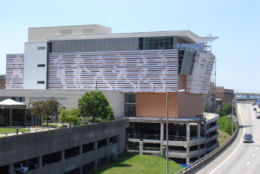
In 2003, the city of Louisville and Jefferson County merged into a single government named Louisville-Jefferson County Metro Government. This merger made Louisville the 16th or 27th most populous city in the U.S., depending on how the population is calculated.
New changes and growth are still evident in the city. The entertainment and retail district called Fourth Street Live! was opened in 2004, and the Muhammad Ali Centre was opened in 2005. Louisville's metro area is outgrowing Lexington's by a significant margin (about 4,100 a year, or 41,000 per census), and is growing nearly as fast as Cincinnati's metro area.
Preservation and presentation of Louisville history
Since 1884, The Filson Historical Society (originally named the Filson Club), with its extensive collections, has led the way in preserving Louisville's history. The University of Louisville and the Louisville Free Public Library have also maintained extensive historical collections.
Unlike some neighboring major cities, such as Cincinnati, Louisville does not have a museum dedicated to the complete history of Louisville, but various museums and historic homes present displays devoted to this history. Prominent among these locations include the Falls of the Ohio State Park interpretive centre, Historic Locust Grove, and the Thomas D. Clark Centre for Kentucky History in Frankfort.
